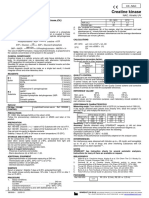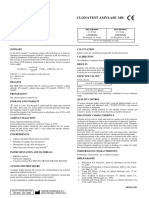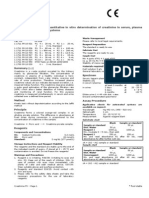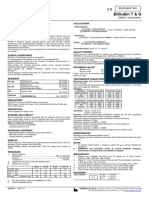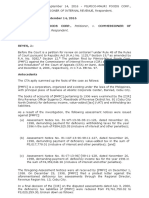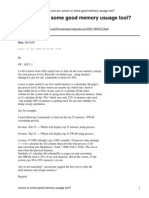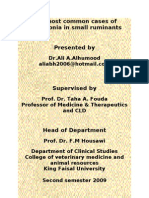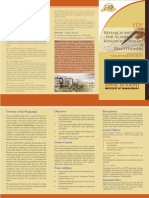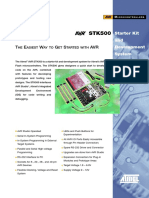Creatinina - 2015 1001111 PDF
Creatinina - 2015 1001111 PDF
Uploaded by
Ing BiomédicoCopyright:
Available Formats
Creatinina - 2015 1001111 PDF
Creatinina - 2015 1001111 PDF
Uploaded by
Ing BiomédicoOriginal Title
Copyright
Available Formats
Share this document
Did you find this document useful?
Is this content inappropriate?
Copyright:
Available Formats
Creatinina - 2015 1001111 PDF
Creatinina - 2015 1001111 PDF
Uploaded by
Ing BiomédicoCopyright:
Available Formats
CREATININE -J
Creatinine
Jaff. Colorimetric - kinetic
5.
Quantitative determination of creatinine
IVD
6.
Read the absorbance (A1) after 30 seconds and after 90 seconds (A2) of the
sample addition.
Calculate: A= A2 A1.
Store at 2-8C
CALCULATIONS
PRINCIPLE OF THE METHOD
The assay is based on the reaction of creatinine with sodium picrate as
described by Jaff.
Creatinine reacts with alkaline picrate forming a red complex. The time
interval chosen for measurements avoids interferences from other serum
constituents.
The intensity of the color formed is proportional to the creatinine
concentration in the sample1.
CLINICAL SIGNIFICANCE
Creatinine is the result of the degradation of the creatine, component of
muscles, it can be transformed into ATP, that is a source of high energy for
the cells. The creatinine production depends on the modification of the
muscular mass, and it varies little and the levels usually are very stable.
Is excreted by the kidneys. With progressive renal insufficiency there is
retention in blood of urea, creatinine and uric acid.
Elevate creatinine level may be indicative of renal insufficiency1,4,5.
Clinical diagnosis should not be made on a single test result; it should
integrate clinical and other laboratory data.
REAGENTS
R1
Picric Reagent
Picric acid
17,5 mmol/L
R2
Alkaline Reagent
Sodium hydroxide
CREATININE CAL
Creatinine aqueous primary standard 2 mg/dL
0,29 mol/L
PRECAUTIONS
R1(Picric acid)/ R2(NaOH) / WR: Corrosive (C):R35:Causes severe burns.
S26: In case of contact with eyes, rinse immediately with plenty of water
and seek medical advice. S37/39: Wear suitable gloves and eye/face
protection. S45: In case of accident or if you feel unwell, seek medical
advices immediately.
PREPARATION
Working reagent (WR):
Mix equal volumes of R 1 Picric Reagent and R 2 Alkaline reagent.
The working reagent is stable for 15 days at 2-8C or 7 days at room
temperature (15-25C).
STORAGE AND STABILITY
All the components of the kit are stable until the expiration date on the
label when stored tightly closed at 2-8C, protected from light and
contaminations prevented during their use.
Do not use reagents over the expiration date.
Signs of reagent deterioration:
- Presence of particles and turbidity.
- Blank absorbance (A) at 492 nm 1,80.
ADDITIONAL EQUIPMENT
- Spectrophotometer or colorimeter measuring at 492 nm (490-510).
- Matched cuvettes 1,0 cm light path.
- General laboratory equipment.
SAMPLES
- Serum or heparinized plasma1.
Creatinine stability: 24 hours at 2-8C.
- Urine (24 h)1 : Dilute sample 1/50 with distilled water. Mix. Multiply results
by 50 (dilution factor);
Creatinine stability: 7 days at 2-8C.
PROCEDURE
1.
Assay conditions:
Wavelength: . . . . . . . . . . . . . . . . . . 492 nm (490-510)
Cuvette: . . . . . . . . . . . . . . . . . . . . . . . . 1 cm. light path
Temperature: . . . . . . . . . . . . . . . . . . . . 37C / 15-25C
2.
Adjust the instrument to zero with distilled water.
3.
Pipette into a cuvette (Note 3) :
Blank
Standard
WR (mL)
1,0
1,0
-100
Standard(Note 1,2) (L)
--Sample (L)
4.
Mix and start stopwatch.
BSIS13-I
12/01/15
Sample
1,0
-100
A Sample - ABlank
A Standard - ABlank
x 2 (Standard conc.) = mg/dL of creatinine in the sample
Conversion factor: mg/dL x 88,4 = mol/L.
QUALITY CONTROL
Control sera are recommended to monitor the performance of assay procedures:
SPINTROL H Normal and Pathologic (Ref. 1002120 and 1002210).
If control values are found outside the defined range, check the instrument,
reagents and calibrator for problems.
Each laboratory should establish its own Quality Control scheme and corrective
actions if controls do not meet the acceptable tolerances.
REFERENCE VALUES1
Serum or plasma:
Male
0,7 - 1,4 mg/dL
61,8 123,7 mol/L
0,6 - 1,1 mg/dL
53,0 97,2 mol/L
Female
Urine: 15-25 mg/Kg/24 h
Male
10 - 20 mg/Kg/24 h
Female
8 18 mg/Kg/24 h
These values are for orientation purpose; each laboratory should establish its
own reference range.
PERFORMANCE CHARACTERISTICS
Measuring range: From detection limit of 0,000 mg/dL to linearity limit of 35
mg/dL.
If the results obtained were greater than linearity limit, dilute the sample 1/2 with
NaCl 9 g/L and multiply the result by 2.
Precision:
Intra-assay (n=20)
Inter-assay (n=20)
Mean (mg/dL)
0,92
3,43
0,96
3,50
SD
0,03
0,07
0,04
0,09
CV (%)
2,76
1,90
3,97
2,51
Sensitivity: 1 mg/dL = 0, 0407 Abs/min .
Accuracy: Results obtained using SPINREACT reagents (y) did not show
systematic differences when compared with other commercial reagents (x).
The results obtained using 50 samples were the following:
Correlation coefficient (r): 0, 99584
Regression equation: y= 0,953x + 0,075
The results of the performance characteristics depend on the analyzer used.
INTERFERENCES
Hemoglobin (1 g/L), Bilirrubin (55 mg/dL), interfere1.
A list of drugs and other interfering substances with creatinine determination has
been reported2,3.
NOTES
1.
CREATININE CAL: Proceed carefully with this product because due its
nature it can get contamined easily.
2.
Calibration with the aqueous Standard may cause a systematic error in
automatic procedures. In these cases, it is recommended to use a serum
Calibrator.
3.
Use clean disposable pipette tips for its dispensation.
4.
SPINREACT has instruction sheets for several automatic analyzers.
BIBLIOGRAPHY
1.
Murray R.L. Creatinine. Kaplan A et al. Clin Chem The C.V. Mosby Co. St
Louis. Toronto. Princeton 1984; 1261-1266 and 418.
2.
Young DS. Effects of drugs on Clinical Lab. Tests, 4th ed AACC Press,
1995.
3.
Young DS. Effects of disease on Clinical Lab. Tests, 4th ed AACC 2001.
4.
Burtis A et al. Tietz Textbook of Clinical Chemistry, 3rd ed AACC 1999.
5.
Tietz N W et al. Clinical Guide to Laboratory Tests, 3rd ed AACC 1995.
PACKAGING
Ref: 1001110
Ref: 1001111
Ref: 1001112
Ref: 1001113
Cont.
R1: 1 x 50 mL, R2: 1 x 50 mL, CAL: 1 x 2 mL
R1: 1 x 150 mL, R2: 1 x 150 mL, CAL: 1 x 5 mL
R1: 1 x 1000 mL, R2: 1 x 1000 mL, CAL: 1 x 5 mL
R1: 2 x 250 mL, R2: 2 x 250 mL, CAL: 1 x 5 mL
SPINREACT, S.A./ S.A.U. Ctra.Santa Coloma, 7 E-17176 SANT ESTEVE DE BAS (GI) SPAIN
Tel. +34 972 69 08 00 Fax +34 972 69 00 99. e-mail: spinreact@spinreact.com
CREATININE -J
Creatinina
Jaff. Colorimtrico - cintico
Determinacin cuantitativa de creatinina
IVD
4.
5.
Conservar a 2-8C
PRINCIPIO DEL MTODO
El ensayo de la creatinina esta basado en la reaccin de la creatinina con
el picrato de sodio descrito por Jaff.
La creatinina reacciona con el picrato alcalino formando un complejo
rojizo. El intervalo de tiempo escogido para las lecturas permite eliminar
gran parte de las interferencias conocidas del mtodo.
La intensidad del color formado es proporcional a la concentracin de
creatinina en la muestra ensayada1.
SIGNIFICADO CLNICO
La creatinina es el resultado de la degradacin de la creatina,
componente de los msculos y puede ser transformada en ATP, fuente
de energa para las clulas.
La produccin de creatinina depende de la modificacin de la masa
muscular. Vara poco y los niveles suelen ser muy estables.
Se elimina a travs del rin. En una insuficiencia renal progresiva hay
una retencin en sangre de urea, creatinina y cido rico.
Niveles altos de creatinina son indicativos de patologa renal1,4,5.
El diagnstico clnico debe realizarse teniendo en cuenta todos los datos
clnicos y de laboratorio.
REACTIVOS
R1
Reactivo Pcrico
R2
Reactivo Alcalinizante
CREATININE CAL
cido pcrico
Hidrxido sdico
17,5 mmol/L
0,29 mol/L
Patrn primario acuoso de Creatinina 2 mg/dL
PRECAUCIONES
R1(cido pcrico)/ R2(NaOH)/ RT: Corrosivo (C): R35: Provoca
quemaduras graves. S26: En caso de contacto con los ojos, lavar de
inmediato con abundante agua y acudir al medico. S37/39: Usar guantes
adecuados y proteger cara y ojos. S45: En caso de accidente o malestar,
acudir inmediatamente al mdico.
PREPARACIN
Reactivo de trabajo (RT): Mezclar volmenes iguales de R 1 Reactivo
Pcrico y de R 2 Reactivo Alcalinizante.
Estabilidad del reactivo de trabajo: 15 das a 2-8C o 7 das a temperatura
ambiente (15-25C).
CONSERVACIN Y ESTABILIDAD
Todos los componentes del kit son estables, hasta la fecha de caducidad
indicada en la etiqueta, cuando se mantienen los frascos bien cerrados a
2-8C, protegidos de la luz y se evita su contaminacin. No usar reactivos
fuera de la fecha indicada.
Indicadores de deterioro de los reactivos:
- Presencia de partculas y turbidez.
- Absorbancia (A) del Blanco a 492 nm 1,80.
MATERIAL ADICIONAL
- Espectrofotmetro o analizador para lecturas a 492 nm (490-510).
- Cubetas de 1,0 cm de paso de luz.
- Equipamiento habitual de laboratorio.
MUESTRAS
- Suero o plasma heparinizado1.
Estabilidad de la creatinina: 24 horas a 2-8C.
- Orina (24 h)1 : Diluir la muestra al 1/50 con agua destilada. Mezclar.
Multiplicar el resultado obtenido por 50 (factor de dilucin)
Estabilidad de la creatinina: 7 das a 2-8C.
PROCEDIMIENTO
1.
Condiciones del ensayo:
Longitud de onda: . . . . . . . . . . . . . . . 492 nm (490-510)
Cubeta: . . . . . . . . . . . . . . . . . . . . . . . . 1 cm paso de luz
Temperatura: . . . . . . . . . . . . . . . . . . . . . . 37C / 15-25C
2.
Ajustar el espectrofotmetro a cero frente a agua destilada.
3.
Pipetear en una cubeta (Nota 3) :
Blanco
Patrn
Muestra
RT (mL)
1,0
1,0
1,0
-100
-Patrn (Nota1,2) (L)
Muestra (L)
--100
BSIS13-E
12/01/15
6.
Mezclar y poner en marcha el cronmetro.
Leer la absorbancia (A1) al cabo de 30 segundos y al cabo de 90
segundos (A2) de la adicin de la muestra.
Calcular: A= A2 A1 .
CLCULOS
A Muestra - ABlanco
A Patrn - ABlanco
x 2 (Conc. Patrn) = mg/dL de creatinina en la muestra
Factor de conversin: mg/dL x 88,4= mol/L.
CONTROL DE CALIDAD
Es conveniente analizar junto con las muestras sueros control valorados:
SPINTROL H Normal y Patolgico (Ref. 1002120 y 1002210).
Si los valores hallados se encuentran fuera del rango de tolerancia, revisar el
instrumento, los reactivos y el calibrador.
Cada laboratorio debe disponer su propio Control de Calidad y establecer
correcciones en el caso de que los controles no cumplan con las tolerancias.
VALORES DE REFERENCIA1
Suero o plasma:
Hombres
0,7 - 1,4 mg/dL
61,8 - 123,7 mol/L
Mujeres
0,6 - 1,1 mg/dL
53,0 - 97,2 mol/L
Orina: 15-25 mg/Kg/24 h
Hombres
10 - 20 mg/Kg/24 h
Mujeres
8 -18 mg/Kg/24 h
Estos valores son orientativos. Es recomendable que cada laboratorio
establezca sus propios valores de referencia.
CARACTERSTICAS DEL MTODO
Rango de medida: Desde el lmite de deteccin de 0,000 mg/dL hasta el lmite
de linealidad de 35 mg/dL.
Si la concentracin es superior al lmite de linealidad, diluir la muestra 1/2 con
ClNa 9 g/L y multiplicar el resultado final por 2.
Precisin:
Media (mg/dL)
SD
CV (%)
Intraserie (n=20)
0,92
3,43
0,03
0,07
2,76
1,90
Interserie (n=20)
0,96
3,50
0,04
0,09
3,97
2,51
Sensibilidad analtica: 1 mg/dL = 0,0407 Abs/min.
Exactitud: Los reactivos de SPINREACT (y) no muestran diferencias
sistemticas significativas cuando se comparan con otros reactivos comerciales
(x).
Los resultados obtenidos con 50 muestras fueron los siguientes:
Coeficiente de correlacin (r): 0,99584
Ecuacin de la recta de regresin: y= 0,953x + 0,075
Las caractersticas del mtodo pueden variar segn el analizador utilizado.
INTERFERENCIAS
Hemoglobina (1 g/L), Bilirrubina (55 mg/dL), interfiere1.
Se han descrito varias drogas y otras substancias que interfieren en la
determinacin de la creatinina2,3.
NOTAS
1. CREATININE CAL: Debido a la naturaleza del producto, es aconsejable
tratarlo con sumo cuidado ya que se puede contaminar con facilidad.
2. La calibracin con el Patrn acuoso puede dar lugar a errores sistemticos
en mtodos automticos. En este caso, se recomienda utilizar calibradores
sricos.
3. Usar puntas de pipeta desechables limpias para su dispensacin.
4. SPINREACT dispone de instrucciones detalladas para la aplicacin de
este reactivo en distintos analizadores.
BIBLIOGRAFA
1.
2.
3.
4.
5.
Murray R.L. Creatinine. Kaplan A et al. Clin Chem The C.V. Mosby Co. St Louis.
Toronto. Princeton 1984; 1261-1266 and 418.
Young DS. Effects of drugs on Clinical Lab. Tests, 4th ed AACC Press, 1995.
Young DS. Effects of disease on Clinical Lab. Tests, 4th ed AACC 2001.
Burtis A et al. Tietz Textbook of Clinical Chemistry, 3rd ed AACC 1999.
Tietz N W et al. Clinical Guide to Laboratory Tests, 3rd ed AACC 1995.
PRESENTACIN
Ref: 1001110
Ref: 1001111
Ref: 1001112
Ref: 1001113
Cont.
R1: 1 x 50 mL, R2: 1 x 50 mL, CAL: 1 x 2 mL
R1: 1 x 150 mL, R2: 1 x 150 mL, CAL: 1 x 5 mL
R1: 1 x 1000 mL, R2: 1 x 1000 mL, CAL: 1 x 5 mL
R1: 2 x 250 mL, R2: 2 x 250 mL, CAL: 1 x 5 mL
SPINREACT, S.A./ S.A.U Ctra.Santa Coloma, 7 E-17176 SANT ESTEVE DE BAS (GI) SPAIN
Tel. +34 972 69 08 00 Fax +34 972 69 00 99. e-mail: spinreact@spinreact.com
You might also like
- Personal Finance by Jack Kapoor, Les Dlabay, Robert J. HughesDocument848 pagesPersonal Finance by Jack Kapoor, Les Dlabay, Robert J. HughesSteph Domingo50% (2)
- Drew D3 Service Manual, Rev 1 PDFDocument60 pagesDrew D3 Service Manual, Rev 1 PDFIng Biomédico25% (4)
- Gravel Road Design To AASHTO 1993Document3 pagesGravel Road Design To AASHTO 1993Robeatul Adawiah OsmanNo ratings yet
- A93a01225cen Glucose Pap CPDocument6 pagesA93a01225cen Glucose Pap CPimrecoNo ratings yet
- Lab Policies C Reactive Protein CRP - Cobas c501 Lab 4232Document4 pagesLab Policies C Reactive Protein CRP - Cobas c501 Lab 4232Wisnu Dwi PutraNo ratings yet
- Is British English Being Swamped by AmericanismsDocument70 pagesIs British English Being Swamped by AmericanismsNick WalkerNo ratings yet
- Bsis13-I Creatinina 2014Document1 pageBsis13-I Creatinina 2014Alejandra MoralesNo ratings yet
- Creatinine: Quantitative Determination of CreatinineDocument2 pagesCreatinine: Quantitative Determination of CreatinineSamuel GCNo ratings yet
- KR10150 Rev02Document2 pagesKR10150 Rev02KOUAME EDYMAIN FRANCISNo ratings yet
- Mdbsis45 Uric Liq 03-2012Document2 pagesMdbsis45 Uric Liq 03-2012juanNo ratings yet
- Inserto CKDocument2 pagesInserto CKSofia OjedaNo ratings yet
- Inserto CHOL - LIQ SPINREACTDocument2 pagesInserto CHOL - LIQ SPINREACTIng Biomédico0% (1)
- ChlorideDocument2 pagesChlorideGeorge-Alexandru MarinescuNo ratings yet
- Clonatest Amylase MRDocument4 pagesClonatest Amylase MRSuprovet LabotatorioNo ratings yet
- CSF ProteinDocument1 pageCSF ProteinPhong Nguyễn WindyNo ratings yet
- KR10060Document2 pagesKR10060KOUAME EDYMAIN FRANCISNo ratings yet
- Glucose KitDocument2 pagesGlucose KitJuan Enrique Ramón OrellanaNo ratings yet
- 174 - 13 UREA PDF - 28-Euro Procedure SheetDocument2 pages174 - 13 UREA PDF - 28-Euro Procedure SheetP VijayaNo ratings yet
- 14 CreatinineDocument8 pages14 CreatinineAzhar Clinical Laboratory TubeNo ratings yet
- Quantitative Determination of Alkaline Phosphatase (ALP) IVDDocument1 pageQuantitative Determination of Alkaline Phosphatase (ALP) IVDPhong Nguyễn WindyNo ratings yet
- BIOPRO J MET Uric Acid 508Document15 pagesBIOPRO J MET Uric Acid 508musembijosef2011No ratings yet
- Lab Policies Alkaline Phosphatase C311 Lab 8803Document4 pagesLab Policies Alkaline Phosphatase C311 Lab 8803Valdez Francis ZaccheauNo ratings yet
- HDL Cholesterol: HDLC - PDocument2 pagesHDL Cholesterol: HDLC - PMariiCarmen Ferez FeraldhNo ratings yet
- CholinesteraseDocument2 pagesCholinesteraseGeorge-Alexandru MarinescuNo ratings yet
- SGPT Serum Glutamic Pyruvic TransaminaseDocument2 pagesSGPT Serum Glutamic Pyruvic TransaminaseNaveed WarraichNo ratings yet
- Creatinine FS PDFDocument2 pagesCreatinine FS PDFChafa NickNo ratings yet
- CT10152 Creatinine EDocument2 pagesCT10152 Creatinine ELaboratorio BianucciNo ratings yet
- BSIS77 CREATININA Enzimatica 1001115-17 2011Document2 pagesBSIS77 CREATININA Enzimatica 1001115-17 2011Nghi NguyenNo ratings yet
- Biopro J Met Bun 508Document15 pagesBiopro J Met Bun 508joseph bundaNo ratings yet
- Sop For Determination of Uric Acid by Colorimetry 5Document4 pagesSop For Determination of Uric Acid by Colorimetry 5david mchembeNo ratings yet
- 5-Alkaline PhosphataseDocument7 pages5-Alkaline PhosphataseAzhar Clinical Laboratory TubeNo ratings yet
- 1105000I Rev. 02Document2 pages1105000I Rev. 02Riadh BenyoucefNo ratings yet
- WWW - Diameb.ua Manuals Eng D95595Document2 pagesWWW - Diameb.ua Manuals Eng D95595Dian Ayu UtamiNo ratings yet
- PotasiumDocument2 pagesPotasiumlabextreme29No ratings yet
- 157 CT10200Document2 pages157 CT10200thureinwinnNo ratings yet
- AlbuminDocument1 pageAlbuminPhong Nguyễn WindyNo ratings yet
- Lab Policies Triglycerides - Cobas c501 Lab 4455Document4 pagesLab Policies Triglycerides - Cobas c501 Lab 4455Marj MendezNo ratings yet
- AlbuminaDocument4 pagesAlbuminaSuprovet LabotatorioNo ratings yet
- A524 780TM1Document2 pagesA524 780TM1clinical_pathologyNo ratings yet
- ALTL enDocument3 pagesALTL enyolanda0811No ratings yet
- CK NacDocument2 pagesCK NacmrashrafiNo ratings yet
- Creatine Kinase (CK)Document2 pagesCreatine Kinase (CK)Mira SafwatNo ratings yet
- Requerimiento de GlucosaDocument2 pagesRequerimiento de GlucosaDemian LeginNo ratings yet
- AmylaseDocument1 pageAmylasePhong Nguyễn WindyNo ratings yet
- Clinical ChemistryDocument38 pagesClinical Chemistryxox18No ratings yet
- Cholesterol KitDocument2 pagesCholesterol KitRahma Ayu WulandariNo ratings yet
- AAGP2 enDocument3 pagesAAGP2 enLince WijoyoNo ratings yet
- 12521IDocument1 page12521IVe SeptianaNo ratings yet
- CA Calcio MindrayDocument32 pagesCA Calcio Mindrayjcpc272005No ratings yet
- Alpha-AMYLASE BLOSR6x82 ENDocument4 pagesAlpha-AMYLASE BLOSR6x82 ENMeethuanNo ratings yet
- Uric Acid: (Uricase / Pod Method)Document1 pageUric Acid: (Uricase / Pod Method)Dharmesh Patel100% (3)
- 9 AstDocument7 pages9 AstAzhar Clinical Laboratory TubeNo ratings yet
- Urea UvDocument1 pageUrea Uvpsychejane100% (2)
- CreaDocument5 pagesCreaKouame Francis0% (1)
- Glucose (God Pap)Document2 pagesGlucose (God Pap)anggun990% (1)
- Autopure T LDL-C: Specimen Collection & PreservationDocument2 pagesAutopure T LDL-C: Specimen Collection & PreservationNanda Nabilah UbayNo ratings yet
- 732 CT10052Document2 pages732 CT10052thureinwinnNo ratings yet
- Bilirubin Total: Quantitative Determination of BilirubinDocument2 pagesBilirubin Total: Quantitative Determination of BilirubinAlejandra MoralesNo ratings yet
- Budi Altgpt - Doc NewDocument3 pagesBudi Altgpt - Doc NewIrvanda ENVIOUSNo ratings yet
- Creatin in ADocument2 pagesCreatin in AErick AlvarezNo ratings yet
- CreatinineDocument3 pagesCreatinineAustyn ChimbuoyimNo ratings yet
- 1151010I Rev. 04Document2 pages1151010I Rev. 04kirubel demelashNo ratings yet
- Ftna-Assl4 1Document2 pagesFtna-Assl4 1Matthew KingNo ratings yet
- Mindray BC-2800 Trouble Shooting (Ver.1.1, 2008-4-31)Document26 pagesMindray BC-2800 Trouble Shooting (Ver.1.1, 2008-4-31)Ing Biomédico100% (2)
- Mindray BC-3000plus Trouble Shooting (Ver.1.1, 2008-4-31)Document26 pagesMindray BC-3000plus Trouble Shooting (Ver.1.1, 2008-4-31)Ing Biomédico100% (2)
- Circuit Frame RT7600Document1 pageCircuit Frame RT7600Ing BiomédicoNo ratings yet
- RT-7600 Resolution AdjustmentDocument3 pagesRT-7600 Resolution AdjustmentIng BiomédicoNo ratings yet
- Changing CF CardDocument2 pagesChanging CF CardIng BiomédicoNo ratings yet
- Belt Change: Please Loose The Two Screws On 1Document2 pagesBelt Change: Please Loose The Two Screws On 1Ing BiomédicoNo ratings yet
- Inserto Bilirrubina Total y DirectaDocument2 pagesInserto Bilirrubina Total y DirectaIng BiomédicoNo ratings yet
- BC-7000 Communication Protocol V1.4Document15 pagesBC-7000 Communication Protocol V1.4Ing BiomédicoNo ratings yet
- Phosphorus-C - 2016 1001150Document2 pagesPhosphorus-C - 2016 1001150Ing BiomédicoNo ratings yet
- Inserto CHOL - LIQ SPINREACTDocument2 pagesInserto CHOL - LIQ SPINREACTIng Biomédico0% (1)
- Cardistry Tricks TutorialsDocument6 pagesCardistry Tricks TutorialsCarlos Mc5No ratings yet
- Project Report On Branded ShoesDocument5 pagesProject Report On Branded ShoesRohan MishraNo ratings yet
- Product Description: Mobil 1™ 5W-30Document3 pagesProduct Description: Mobil 1™ 5W-30Alexandru Z.No ratings yet
- Drugs@FDA - FDA-Approved DrugsDocument3 pagesDrugs@FDA - FDA-Approved DrugsNguyen binhNo ratings yet
- PILMICO-MAURI Foods Corp. v. CIR, 802 SCRA 618 (2016)Document13 pagesPILMICO-MAURI Foods Corp. v. CIR, 802 SCRA 618 (2016)ekangNo ratings yet
- Comp - Unix.aix: Svmon or Some Good Memory Usuage Tool?Document1 pageComp - Unix.aix: Svmon or Some Good Memory Usuage Tool?mail4prabhakarNo ratings yet
- Ackley 2003Document18 pagesAckley 2003Rosa LinaNo ratings yet
- Pneumonia in Sheep and GoatDocument32 pagesPneumonia in Sheep and Goataliabh2006100% (5)
- Fermentation of Carrot Juice, Wheat Flour, Gram Flour Etc - PDF - Fermentation - Fermentation in Food ProcessingDocument1 pageFermentation of Carrot Juice, Wheat Flour, Gram Flour Etc - PDF - Fermentation - Fermentation in Food ProcessingAman JoshiNo ratings yet
- FEVRE13081999Document23 pagesFEVRE13081999Charly ValerioNo ratings yet
- IELTS Listening Section 1 Transport SurveyDocument4 pagesIELTS Listening Section 1 Transport SurveyKHÁNHNo ratings yet
- Marine Engines ABATO WeichaiDocument14 pagesMarine Engines ABATO Weichaiarf89No ratings yet
- FDP On Research Methods BrochureDocument3 pagesFDP On Research Methods Brochurevsabijith@gmail.comNo ratings yet
- Safety Zone VAT CertificateDocument1 pageSafety Zone VAT CertificateHAREESH PNo ratings yet
- Arrays: Introduction - Variables in A Program Have Values Associated With Them. DuringDocument66 pagesArrays: Introduction - Variables in A Program Have Values Associated With Them. DuringChala GetaNo ratings yet
- Hydraulic Excavator: Model Code Engine Rated Power Operating Weight Backhoe BucketDocument8 pagesHydraulic Excavator: Model Code Engine Rated Power Operating Weight Backhoe Bucketidar100% (3)
- Victoria DLLDocument34 pagesVictoria DLLNiña VictoriaNo ratings yet
- IndexDocument184 pagesIndexmerenkcbsNo ratings yet
- FSM DramDocument10 pagesFSM DramjochenpNo ratings yet
- Ukay2x RhotilesDocument14 pagesUkay2x RhotilesRozelle Ann Marie LicuranNo ratings yet
- Eet 483 Part 1Document24 pagesEet 483 Part 1Albert AwoponeNo ratings yet
- T E W G S AVR: Starter Kit and Development SystemDocument2 pagesT E W G S AVR: Starter Kit and Development SystemSolon CarrenoNo ratings yet
- MINIBOOKDocument19 pagesMINIBOOKkatchinanicolaidesNo ratings yet
- Steering, Axle & Brake PW200/ 220-7Document24 pagesSteering, Axle & Brake PW200/ 220-7Teknik Makina100% (1)
- MD Walkthrough-0.29Document15 pagesMD Walkthrough-0.29ran domNo ratings yet
- Composer Brief - Sally Greenaway - Sean QuinnDocument3 pagesComposer Brief - Sally Greenaway - Sean QuinnSean QuinnNo ratings yet
- D1599EN - Installation, Operaton & Maintenance Manual PAC135XN0M1A2AC0AA For Serial Number 135RX009004UUDocument77 pagesD1599EN - Installation, Operaton & Maintenance Manual PAC135XN0M1A2AC0AA For Serial Number 135RX009004UUCelestin WtiNo ratings yet










